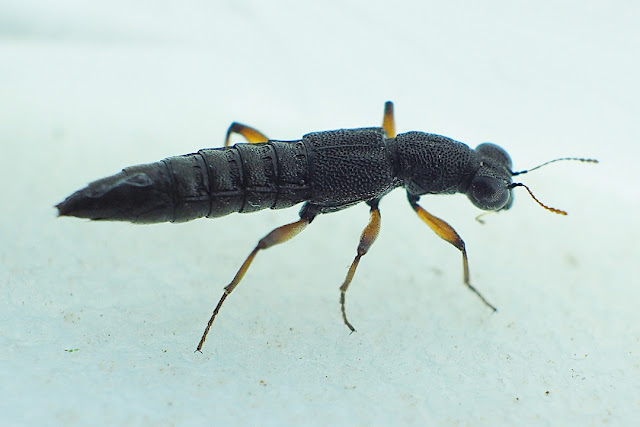Louise is getting slightly concerned at my interest in penises, beetle penises mind, generally referred to as the aedegus. There are going to be a few penis photos in this post, so warning proffered, no need to read on if that's not your bag.
I decided that rather than go through the tubes in the fridge in search of beetles I should venture out for some looking under stones. A wander around the patch, turning stones and a first live beetle, a Stenus sp. These are strange, bug-eyed little staphylinidae that look a little like small stoneflies at first glance. I'm always pleased to find these as they are generally ok to ID. I managed to do this one without killing it with some studio pix that showed all the features needed.
 |
| Stenus clavicornis. |
It turned out to be one I've seen before, released, always nice to do but not possible most often if you want an identification.
At the top of the birdcrop field I turned over a stone that has been particularly productive in the past. A rather dozy Cychrus caraboides was a good find. There were two Bembidion tetracolum as well.
 |
| Bembidion tetracolum, it stayed nice and still for photos and could be released. |
The Bembidion is very common here, the Cychrus, less so, I tend to see 1 - 3 a year. They a snail hunter.
 |
| Cychrus caraboides, evolved to hunt snails. |
That little expedition wet the appetite for something better. So the next day I was down at Marwick. The area behind the seawall and around the burn has been productive in the past.
Sure enough, a bit of searching through flood litter and under nearby stones along the burn yielded some beetles. Having set off incorrectly down the Philonthus path and wondering why the beast would not key out, a clue there, wrong genus, I realised I should be looking at Quedius, and soon ended up in the Quedius s.s. rabbit hole; a difficult subgenus. With improved photographic techniques (see previous post) and the new key (thanks AKH), and a bit more experience I was determined. The end result was that these two were identified as male Quedius curtipennis, finally proving this species for the county, indeed there are few records in Scotland. And thus the penises; as the only way to be certain of this species is to compare photos of aedeagi.
 |
| On this view this is still a tricky ID as the differences are subtle. |
 |
| The lateral view is what is required. Quedius curtipennis. |
Here's the aedegus of Quedius fuliginosus, with thanks to Aslak Kappel Hansen for the image for comparison.
 |
| Quedius fuliginosus, aedegus (photo Aslak Kappel Hansen). |
Oh yes, the whole beetle...
 |
| Quedius by the dorsal series of punctures, three pairs, in the proximal half of the pronotum only, parallel sided abdomen, eyes take up half or more (two thirds in this case) of the side of the head. |
 |
| Between the coxae of the middle legs there is a tiny keel on the metasternum, indicative of Quedius curtipennis. |
 |
| Quedius curtipennis, two live images, the animal is about 12mm long. |
Many thanks to AKH for pre-publication elements of his key, the photo of Q. fuliginosus aedegus and taking the time to look at my photos and confirm the identification.
But these were not the only beasts I found. A couple of Loricera pilicornis represented the carabid clan. Easy to identify and released.
 |
| Loricera pilicornis, long hairs on the antennae and obvious large setiferous punctures on the elytra. (Not a good photo.) |
More staphylinids were found. More aedegus examination required.
Keying these to Lathrobium brunnipes was relatively easy, except for the final couplet (Lott and Anderson). Proving it was L. brunnipes and not one of the other similar species was a whole lot more challenging. Although to my eye, looking at photos, it looked reasonably distinctive. I dissected the first animal which unfortunately turned out to be a female, therefore no penis. Theoretically these can be IDed on the female final tergites but I couldn't see the features illustrated. I opened the elytra to reveal the animal was brachypterous, (small or no wings) unfortunately not 100% proof.
 |
| Lathrobium brunnipes, female. |
At this point I gave up for the evening. However, a bit of correspondence and encouragement from CW and I gave it a further go with the other animal.
I photographed the animal again. I'd thought it was another female but closer examination indicated it might be a male, so I tried another dissection.
 |
| Lathrobium brunnipes, aedegus lateral view. |
 |
| Lathrobium brunnipes ventral view of aedegus. |
Success, and identification proven, and a species NFM, so all round success, it only took a few hours...




No comments:
Post a Comment